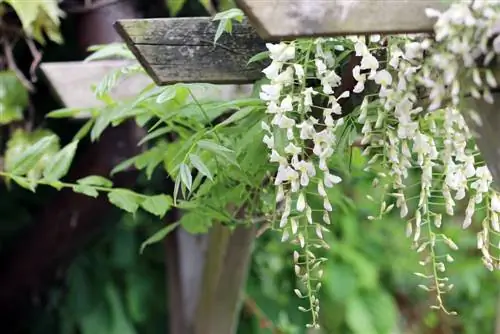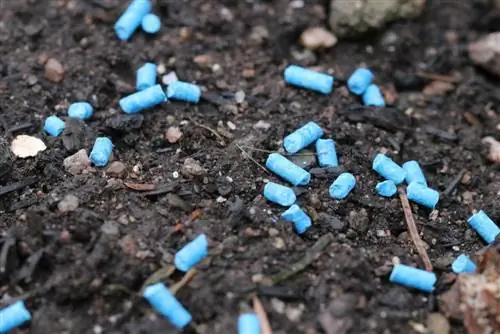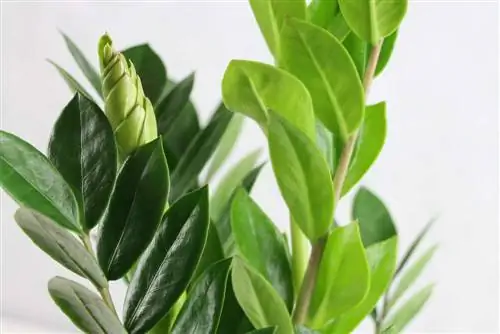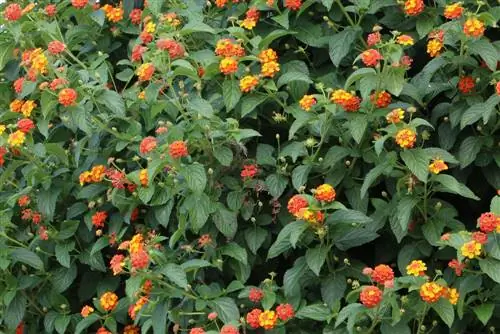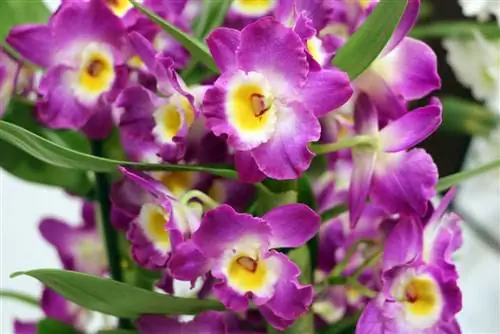- Author admin [email protected].
- Public 2023-12-17 03:39.
- Last modified 2025-06-01 06:48.
Wisteria, also known as wisteria or wisteria, is a traditionally popular climbing plant that manages to conquer entire facades within just a few years. However, the plant should only be planted after careful consideration. Although it is a real highlight in the garden, it is not only maintenance-intensive but also very poisonous. Families with children, but also grandparents who regularly visit grandchildren, should therefore resort to other flowering alternatives when the garden is newly planted. If you already have wisteria in your garden or immediate neighborhood, you don't have to panic or throw the plant away. However, it is helpful to know exactly about the different ingredients that can cause poisoning in children and adults.
What toxins do wisteria seeds contain?
Unfortunately, all parts of wisteria are highly poisonous. However, the individual toxins differ in their type, dosage and consequences for the organism. Lectin is a component in all legumes. The pods, which are around 20 centimeters long, hang on the wisteria throughout the winter. Their shells are very hard and only open when the thermometer slowly climbs back up. Once the bean-like seeds have taken on a dark brown color and are ripe, it usually doesn't take more than a quick tap with your finger for the pod to open suddenly.
There is a loud bang that sounds similar to a gun shot. It doesn't take much imagination to imagine the magical appeal this has on children. Unfortunately, the bang didn't stop there. Poison control centers repeatedly report that little ones tend to put six to seven of the dangerous wisteria seeds in their mouths at once.
What effects does the lectin contained in the seeds have?
The seeds and pods of wisteria contain a high concentration of lectin. The poison is complex proteins that are able to bind to cells and cell membranes. According to some scientists, if lectins are consumed, this causes red blood cells to clump together. Just a few grams of this substance can cause massive symptoms of poisoning. For children, it is enough to consume two wisteria seeds; for adults, symptoms occur from three seeds onwards, which usually appear one to three hours after consumption:
- Stomach cramps
- Diarrhea
- Nausea and vomiting
- Headache
- paleness
- Dilated pupils
In children, consumption of the seeds can be fatal if a doctor is not contacted as quickly as possible.
How does the Wistarin contained in the bark work?

Some people come up with the idea of cutting back the wisteria immediately after flowering so that the poisonous legumes cannot even form. But there are other toxic substances in the roots and bark. Wistarin is only found in wisteria. The poison has been known since the end of the 19th century, when it was first isolated from the bark of the Chinese wisteria, a type of wisteria. According to science, Wistarin is said to have a slightly tart and bitter taste. However, researchers still do not agree on exactly which symptoms the poison can cause. The view has now become established that Wistarin has a similar effect to cystine, which is contained in laburnum. The following symptoms are possible:
- Stimulation of the central nervous system
- Paralysis symptoms
- Burning in the mouth and throat
- Nausea and prolonged vomiting, possibly with blood
- strong thirst
- Cramps
- Headache
- Sweats and states of excitement
- Twitches
- Delirium
If the dose was too high and signs were recognized too late, general paralysis initially occurs, which ultimately progresses to respiratory paralysis combined with circulatory collapse. While children like to put the wisteria legumes in their mouths, this is rarely the case with pieces of roots and bark. The bitter taste will hopefully deter the offspring, but they can still eat the poisonous parts out of arrogance or ignorance. Contact with the poison via the skin is therefore more likely.
How harmful are the alkaloids contained in wisteria?
With over 10,000 representatives, the alkaloids form the largest group of plant ingredients. What they all have in common is that they are toxic, contain nitrogen, are classified as bases and are metabolic end products of amino acids. Alkaloids also have a characteristically bitter taste. The alkaloids, which can be found in all parts of the plant in wisteria, are not as dangerous as lectin and wistarin, but can irritate the skin extremely on contact and cause dermatitis and other painful irritations.
Alkaloids are said to protect the plant from predators; occasionally deaths of small animals, especially rodents, that have tampered with wisteria have been observed. Because children sometimes come up with the greatest ideas while playing, it is important to remind them that wisteria can also be deadly to pets. If dogs or cats are “fed” with the toxins, even small amounts are enough to cause circulatory collapse and cardiac arrest in the animals.
Tip:
The poisonous wisteria is unsuitable for the family garden. Instead of wisteria, climbing hydrangeas, vines and climbing roses are just as beautiful, but do not pose a danger in any way.
What should you do if the child has eaten parts of the wisteria?
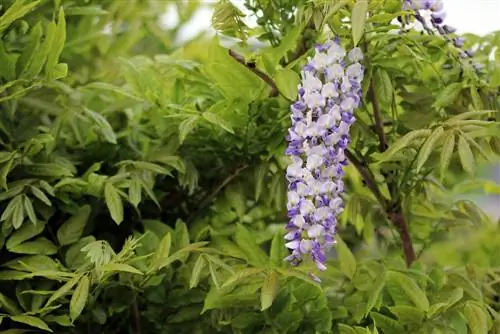
The wisteria is not the only poisonous plant and there are far more dangerous specimens. If a child has consumed parts of wisteria, it helps to keep a cool head. The effect of the toxins is of course always proportional to the amount that has been supplied to the body. So it makes a difference whether one seed or ten were swallowed. What to do if a child has eaten parts of wisteria:
- Call Git emergency center
- DO NOT induce vomiting!!!
- Provide plenty of fluids (sparkling water, juice, tea) - DO NOT give milk!!!
- Give charcoal tablets
- Find out about consumed plant parts
So that it doesn't even get to that point, parents should make their child aware of the dangers wisteria poses and explain to them the dangerous effects of the individual parts of the plant, best by taking a short walk through the garden.
Poison control centers
Berlin
- Poison emergency call of the Charite / Poison emergency call Berlin
- giftnotruf.charite.de
- 0 30-19 24 0
Bonn
- Information Center against Poisoning North Rhine-Westphalia / Poison Center Bonn - Center for Pediatrics University Hospital Bonn
- www.gizbonn.de
- 02 28-19 24 0
Erfurt
- Joint Poison Information Center (GGIZ Erfurt) of the states of Mecklenburg-Western Pomerania, Saxony, Saxony-Anh alt and Thuringia in Erfurt
- www.ggiz-erfurt.de
- 03 61-73 07 30
Freiburg
- Poisoning Information Center Freiburg (VIZ) Freiburg University Hospital
- www.giftberatung.de
- 07 61-19 24 0
Göttingen
- Poison Information Center-North of the states of Bremen, Hamburg, Lower Saxony and Schleswig-Holstein (GIZ-Nord)
- www.giz-nord.de
- 05 51-19 24 0
Homburg/Saar
- Information and Treatment Center for Poisonings, Saarland University Hospital and Medical Faculty of Saarland University
- www.uniklinikum-saarland.de/giftzentrale
- 0 68 41-19 240
Mainz
- Poison Information Center (GIZ) of the states of Rhineland-Palatinate and Hesse - Clinical Toxicology, University Medical Center Mainz
- www.giftinfo.uni-mainz.de
- 0 61 31-19 240
Munich
- Poison emergency call Munich - Department of Clinical Toxicology Klinikum Rechts der Isar - Technical University of Munich
- www.toxinfo.med.tum.de
- 0 89-19 24 0
Poison information centers Austria and Switzerland
Vienna/Austria
- Poisoning Information Center (VIZ) - Gesundheit Österreich GmbH
- www.goeg.at/Vergiftungsinformation
- +43-1-4 06 43 43
Zurich/Switzerland
- Swiss Toxicological Information Center
- www.toxi.ch
- 145 (Switzerland)
- +41-44-251 51 51 (from abroad)

